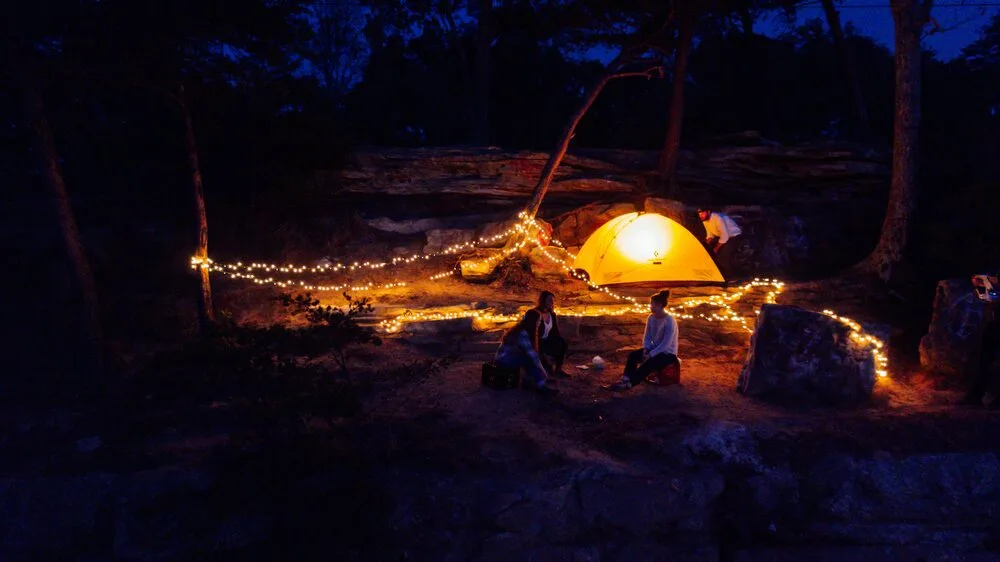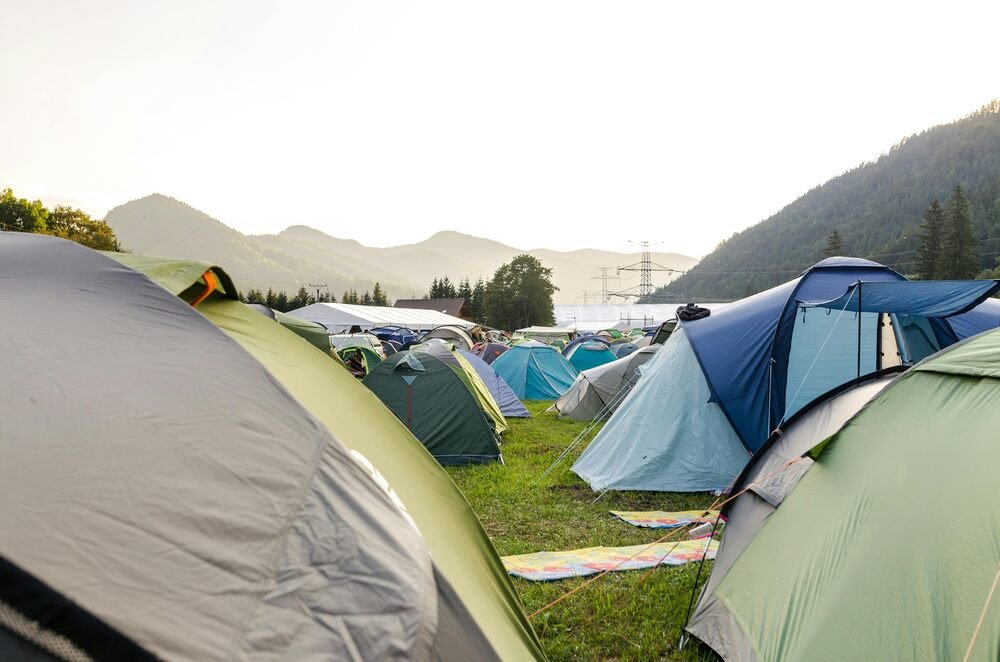Embarking on your first camping adventure can seem daunting, especially when choosing your first campsite and figuring out the essential gear to bring along. To ease into the world of camping, here are several expert-recommended approaches tailored for beginners.
Camping styles range broadly, including car camping, where convenience meets comfort at a drive-up campsite, and overnight backpacking that challenges you to carry all necessities with you. For novices, car camping is an ideal start, allowing the luxury of packing more items like coolers and camp chairs, with the added benefit of onsite facilities such as toilets.
For those who may not have their own camping gear, consider the option of renting a camper van. These vans are typically equipped with all the camping essentials like a stove, cookware, and bedding. Providers such as Escape Campervans and Native Campervans offer fully outfitted vans, converting them into comfortable sleeping spaces.
The best piece of advice for a first-time camper is to keep it simple. Opt for a brief, local outing to familiarize yourself with the camping experience. Choose a campsite that offers crucial amenities, such as bathrooms or showers, to ensure your comfort and enhance your outdoor adventure.
Introduction to choosing a Campsite
Camping remains a cherished global pastime, with its popularity surging notably in recent years. The experience of camping varies significantly across different regions due to unique geographic, cultural, and regulatory contexts.
In North America, the expansive natural landscapes allow for camping that often brings individuals closer to untamed wilderness areas, including national parks and extensive grasslands. Here, campers can enjoy the solitude and vastness of nature.
Conversely, Europe’s approach to camping is shaped by its higher population density and stronger emphasis on conservation. This results in a prevalence of designated campsites equipped with facilities that provide comfort and convenience. Such sites offer toilets, electrical hookups, and running water, catering to those who seek an outdoor experience with home comforts close at hand.
Particularly in Scandinavia, the cultural concept of “freedom to roam,” or “allemannsretten,” permits campers to enjoy wild camping within specific guidelines. However, across much of Europe, strict regulations aim to protect the environment, limiting camping to established sites or private lands to ensure the preservation of natural habitats and wildlife. To learn more about camping regulations in different regions, see our post on can you camp anywhere in Europe?
Thus, while the allure of wild camping remains, many European campers prefer the structured environment of campsites, which seamlessly blend access to nature with the comforts of modern facilities.
Types of Campsites
The camping landscape has evolved to cater to a wide range of preferences, adapting to the desires of newer generations seeking varied outdoor experiences. While traditional large commercial campsites remain popular, they are complemented by a growing array of specialized options.
In Europe and the US, the classic large commercial campsites continue to thrive. These facilities typically offer numerous pitches for tents, RVs, campervans, and trailers. They come equipped with extensive recreational facilities such as swimming pools, playgrounds, and games rooms, which are ideal for family vacations.
However, there has been a noticeable shift towards more intimate and specialized camping experiences. New options like garden campsites, luxurious glamping spots, and smaller, more secluded sites are gaining popularity. These alternatives appeal to those seeking a closer connection with nature or a more private and comfortable outdoor experience.
With the diversity of camping styles now available, choosing the right campsite can seem daunting. As we explore some of the top camping styles currently favored in Europe and the US, you may discover the perfect setting for your upcoming outdoor adventure.
Booking options
Booking the ideal campsite is streamlined with specialized online platforms and apps catering to varied camping preferences, whether you’re looking for specific amenities, locations, or unique accommodations.
Platform Overviews:
Sekr: Known for comprehensive services, Sekr (formerly the vanlife app) provides site locations, local events, Wi-Fi availability, laundry services, and user reviews.
iOverlander: This app is a favorite among off-grid adventurers, offering filters for site features, amenities, and remote accommodations. (worldwide locations)
Harvest Hosts: Ideal for those interested in local culture, this app offers RV camping at breweries and wineries. A $99 annual membership provides unlimited stays, with purchases supporting local hosts.
For European campers, Camping.info offers extensive listings across the continent, complete with user reviews and detailed campsite information.
Booking Your Campsite:
In the U.S., platforms like Recreation.gov, Hipcamp, and ReserveAmerica.com are invaluable for finding public and private campsites. These platforms enable detailed searches based on amenities like water proximity, pet-friendliness, and fire pit availability.
Using these tools effectively can vastly enhance your camping experience, helping you find and book the perfect campsite whether you prefer solitary wilderness or a lively social setting.
Essential Considerations When Choosing a Campsite
Think about water. Where you camp depends on how much water is available. If possible, choose a site near a water source so you don’t have to carry as much. In dry areas, camp as close as you can to a water source (remembering to stay 200ft away to follow Leave No Trace). But sometimes, there’s no way around dry camping – especially in places with limited water.
Dry camping tips:
- If you can, camp soon after filling up with water. This way, you won’t have to carry overnight water very far, but you’ll still make some miles for the next day.
- Consider filtering water, rehydrating, and eating dinner right at the water source. That way, you leave with full bottles and won’t need to use that water for cooking later.
Also consider bugs: If mosquitoes are a problem, camp farther from water. They hatch near water, so while a dry camp doesn’t guarantee safety, there should be fewer bugs. This is especially important if your shelter doesn’t have a bug net.

Identify a suitable spot
Choose a safe campsite: Your top priority is finding a spot away from hazards. Stay clear of places with falling rocks, avalanche risks, or where flash floods could happen. Avoid setting up under lone trees or on exposed ridges, both lightning magnets. And remember, always be respectful of wildlife by steering clear of animal habitats.
Find comfort and resources: A good night’s sleep is crucial! Look for a relatively flat and level spot for your tent. Ideally, you’re near trees or bushes for wind protection, but not so close to stagnant water where bugs breed. Think ahead and camp near a source of firewood and fresh water (remembering to keep a safe distance to avoid contamination).
Test it out: Before unpacking all your gear, lie down where you might pitch your tent. Is the ground too rocky or uneven? Is there a slight slope you hadn’t noticed? A quick test-nap can save you a lot of discomfort later!
Gear Rental Options
Thinking Green? Consider Renting Your Gear If you’re just starting your camping adventures, renting gear is a smart and eco-friendly move. It saves you money and helps reduce the environmental impact of buying new stuff. Luckily, rental options aren’t just for US campers – European companies offer gear rentals too!
Find the Right Rental: Check out stores like REI Co-op (for US rentals) or search online for European rental companies. Many will even ship the gear directly to your starting point.
Tent Tip: Don’t get fooled by tent sizes! For a comfy night, choose a tent sized for at least two more people than you’ll have sleeping in it. This leaves room for you and your gear.
Planning Your Camping Kitchen
Gear Up Smart (and Green!)
Building your camp kitchen doesn’t mean buying a whole new set of stuff. Check your cupboards first – you might be surprised what works for your first campsite! And before hitting the outdoor store, look for used gear to save money and lessen your environmental impact.
Cut the Waste: Say goodbye to disposable plates and cutlery. Invest in a set of reusable dishes that work for camping, picnics, and everyday meals.
Cookware Must-Haves: Start with a good-sized pot, a skillet, and a lid. Want that campfire cooking experience? A cast-iron Dutch oven is the ultimate in versatility.
Stove Smarts: Even if you love cooking over fire, a camp stove adds flexibility. Choose a single-burner for basics or a two-burner if you’ll be cooking for a group. A windscreen helps your fuel go further.
Don’t Forget Cleanup: A simple plastic tub becomes your camp “sink” for washing dishes and hauling water. Pack biodegradable soap, a sponge, a scraper, and a way to filter out food scraps for packing out.
Assessing Environmental Factors
Don’t Get Soaked! Spotting Rain Trouble
Choosing the right campsite on your first camping trip is all about avoiding a soggy night. Look for higher ground where water naturally drains away, and stay clear of any dips or depressions that could become puddles.
Think Beyond the Rain: Be wary of dry washes or channels, especially in areas known for flash floods. These can turn into raging rivers in a heartbeat! When in doubt, err on the side of caution and camp well away from those tempting flat spots.
Watch the Ground: If your tent isn’t fully waterproof around the edges, consider the surface you’re pitching on. Pine needles, dry leaves, and sand minimize splash back and can save you some soggy surprises.
Respecting the Outdoors: A great campsite looks the same when you leave as it did when you arrived. Always pack out all your trash. And if you wash dishes, strain leftover food scraps out of the water and dispose of them properly.
Want to learn more about minimizing your impact? The Leave No Trace organization offers a free online tutorial packed with tips on eco-friendly camping practices.
Safety and Comfort
Choosing a campsite isn’t just about the tent spot itself. Here’s what to consider:
- Safety First: Do your homework on the area. What’s the wildlife situation? Are there natural hazards to be aware of?
- Creature Comforts: Check what facilities the campground offers. Clean restrooms and showers can make a big difference! Do they allow pets? Are there laundry facilities?
- Know the Rules: Every campground has its own regulations. Find out about fire pits, quiet hours, and other important policies beforehand.
- Beyond the Campsite: Are there swimming areas (and lifeguards if needed)? Can you easily reach day trip destinations?
- Be Prepared: It’s always smart to know where the nearest gas station and medical help is located, especially if cell service is spotty.
Practical Setup Tips
Choosing the perfect tent spot when you go camping is just the beginning! Here’s what to do next:
- Scan the Ground: Clear away anything sharp that could damage your tent – a few minutes of prep saves a lot of patching later. Keep an eye out for signs of animal activity or potential bug hangouts too.
- Stake It Down: Wind can be unpredictable. Always stake your tent to keep it from taking an unexpected trip.
- Critter-Proof Your Stuff: Food, toiletries, anything with a scent… seal it up and store it away from your tent (ideally in your car). This isn’t just about bears – even mice can be curious campers!
- Sleeping Smart: Set up your sleep area with your pad, sleeping bag, and a few essentials close by for nighttime convenience.
- Warmth is Key: Temperatures can drop, even in summer. Pack layers – an extra jacket makes all the difference on a cool night.
- Power Perks: Want to bring electronics? Some campgrounds have hookups – check the details when you book.
- Fire Safety: Stick to designated pits. Gather kindling or bring fire starters to help things along. And always, always make sure your fire is fully extinguished before you leave. You must learn to master fire safety in dry conditions.
Booking and Arrival Procedures
Score the Best Campsite (and Arrive Smoothly)
- Plan Ahead = Camping Bliss: Want that perfect spot by the lake? Popular campgrounds book up FAST, especially in national parks. Start planning early and reserve as soon as booking opens to get your pick.
- Know Your Needs: Do you want bathrooms nearby? Electrical hookups? Privacy from other campers? Research campgrounds carefully to find the best fit for you.
- The Online Advantage: Booking sites like ReserveAmerica.com let you compare sites, see photos, and even read reviews. Do your homework before clicking ‘reserve’!
- Sometimes, Luck is Key: Keep checking for cancellations, especially right before your trip. Someone else’s change of plans could be your camping win!
- Arrival 101: Most campgrounds have a check-in area. Be a good campsite visitor and have your reservation info handy, and they’ll get you set up with your campsite number and any important info about the park.
Pack for Success
Campsite Essentials: What to Pack (and What to Check)
- Know the Rules: Every campground has its own regulations. Always check what’s allowed (and what’s not!) before packing to avoid any hassles.
- Lodging Matters: Are you in a tent, an RV, or a furnished cabin? This changes your packing list! Call ahead and find out what basics they provide so you don’t double up.
- Comfort is Key: Don’t forget the little things that make a big difference. A battery fan, earplugs, a sleep mask… these can be lifesavers on your first few camping trips.
Emergency Prep = Peace of Mind
No matter how well you plan, things can happen. Here’s your emergency kit starter list:
- Food & Water: Non-perishable snacks and lots of clean water are your lifeline. A water purifier is a wise investment if you might need to refill on the go.
- First-Aid: From scrapes to serious stuff, having a well-stocked kit lets you handle anything. Don’t forget sunscreen and bug repellent!
- Light and Communication: A headlamp frees up your hands, and a weather radio is essential if cell service goes down.
- The Extras: A simple map, a multi-tool, and a way to start a fire can get you out of a jam. A backup battery keeps your phone alive for emergencies.
Your Adventure Begins!
By now, you’re armed with the knowledge to make your first camping trip a success. From finding the perfect spot to packing the right gear, you’ve considered all the essentials. Remember, start simple, choose locations close to home, and focus on comfort those first few times out.
Ready to take the next step?
- Explore Resources: Learn the principles of Leave No Trace to minimize your camping impact… or find campsites on public lands at Recreation.gov… Discover even more helpful resources for booking and trip planning on similar sites.
- Join a community: Connect with fellow campers on forums or social media for advice and inspiration. Many local outdoor clubs offer beginner-friendly camping trips too!
- Gear Up: If you discover you love camping, start building your own gear collection (remember, used gear is a great option!).
Camping opens a world of outdoor adventure. With each trip, you’ll gain confidence and discover the unique joy of a night under the stars. So, what are you waiting for? Start planning, get packing, and experience the magic for yourself!

